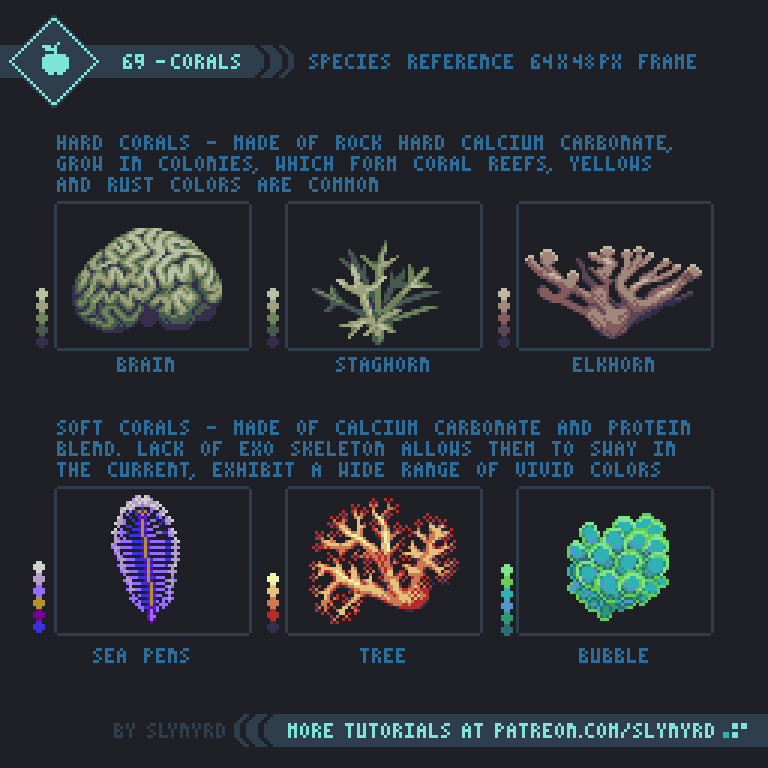Intro
At a fundamental level, visual art is observation and interpretation of the natural world we live in. Therefore, in order to become a well rounded artist, it’s imperative to keenly study the many realms of nature and depict what you see. No matter how strong your sense of imagination is, frequent natural studies will prove to sharpen your vision. What’s more, you will develop a deeper understanding of the objects you depict. After all, anything imagined must have a source of inspiration in the real world.
In a constant quest to strengthen artistic vision and broaden visual vocabulary, I’ve covered several natural studies in previous lessons, such as plant life, and rock formations. In this lesson I dive into one of the most beautiful and mysterious environments on the planet - the ocean! Broad and diverse the world of the ocean is, for it can’t be covered in one lesson. Moreover, for this lesson, I focus on corals and algae. Also, as a bonus I included a submarine tutorial, so we have a watercraft to explore this wonderful world in.
Coral
One of the most unique lifeforms in the ocean, corals come in many forms. Sometimes appearing as rocks, or plants, corals are in fact animals. Actually, a single coral is made up of thousands of tiny animals called polyps. Wow!
As you can see there are two main kinds of corals, hard and soft. Hard corals are made of calcium carbonate, and the polyps create an exoskeleton, making them hard as rock. Hard corals grow in colonies, eventually forming coral reefs. Hard corals commonly come in yellows and rust colors.
Soft corals are also made of calcium carbonate, but with a blend of protein, which makes them less rigid. Although rooted, a lack of an exoskeleton allows soft corals to sway back and forth. Soft corals come in a wide range of vivid colors.
ALGAE
Commonly referred to as seaweeds, algae make up most of the plant life in the ocean. As a fan of Japanese cuisine I was already familiar with a few species, but I was surprised to discover there is an extensive list of known species, and they exhibit great diversity in appearance.
Although they may be called seaweeds, algae are not plants. Algae use chlorophyll for photosynthesis and have plant-like cell walls, however, they do not produce seeds or flowers like plants do.
At the basic level, algae are classified as 3 main types; brown, red, and green.
Brown algae is the most prevalent, and touts the largest species. Seaweeds known as kelp are brown algae.
Red algae get their red color from a pigment called phycoerythrin. The ability to absorb blue light allows red algae to live at greater depths than either brown or green algae. A sub group of red algae called Coralline algae contain calcareous deposits, which makes them hard like corals. Pink Plates is an example of Coralline algae.
Green algae is the least common but there are still more than 4000 species on the planet. These algae come in three forms: unicellular, colonial, or multicellular. However, the diversity among green algae is not as great as among red and brown algae, with most species appearing like some kind of sea lettuce.
Submarine
While it’s not really in line with the topic of natural studies, it’s equally important to study man made objects. The value comes from observation. However, I find natural subjects to be more insightful and inspiring. Anyway, figured we needed a watercraft for this underwater adventure.
After studying several different subs, I came up with this general design, which exhibits the main parts needed for proper operation. The hull is a pressurized container that makes up the main interior space where the crew operates from. The conning tower is a raised platform on top the ship from which the ship can be operated when on the surface, and contains the periscope. The rudders control the direction of the ship. Vertical rudders control the yaw, or left and right movement, while the horizontal rudders allow the vessel to dive and ascend. Obviously, both are necessary. Finally, the propeller provides propulsion. As long as you have these basic components, it should be a convincing sub design. Play around with different shapes, dimensions, and colors!
FINAL THOUGHTS
Growing up as land locked as it gets in Kansas, I’ve always thought of the ocean as an exotic and majestic realm. The first time I went to a large aquarium in Tokyo I was blown away by the lifeforms on display, and infinitely inspired. Although I had been to the ocean before and had a basic education on marine life, it was like discovering a whole new world. With this lesson I decided to start with the basic life forms, but there is so much more to explore. I’m sure I will revisit underwater environments, and cover different kinds of sea life in the future.
RESOURCES
Was this article helpful? If you find value in my content please consider becoming a Patreon member. Among many other rewards, Pixel Insider members get extra resources to compliment my tutorials. But most importantly, you allow me to continue making new content.
Assets featured in this Pixelblog are available in Under the Sea Asset Pack
Source file used in the making of this Pixeblog is available in Tutorial 71 Source File
Get caught up on all my downloads
If you're not ready to commit to the subscription model of Patreon, make a one-time donation and receive exclusive art and resources. Help continue the content by providing me a living. Thank you!
-By Raymond Schlitter



